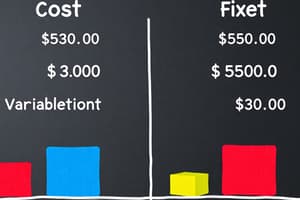Podcast
Questions and Answers
Which type of cost changes in proportion to changes in the activity base?
Which type of cost changes in proportion to changes in the activity base?
- Fixed costs
- Direct material costs
- Variable costs (correct)
- Mixed costs
What is the characteristic of fixed costs with respect to cost per unit as the activity level increases?
What is the characteristic of fixed costs with respect to cost per unit as the activity level increases?
- Increases
- Decreases (correct)
- Remains the same
- Fluctuates
Which method is used to separate mixed costs into their fixed and variable components?
Which method is used to separate mixed costs into their fixed and variable components?
- Activity-Based Costing Method
- High-Low Method (correct)
- Fixed-Cost Allocation Method
- Straight-Line Depreciation Method
What are the characteristics of mixed costs?
What are the characteristics of mixed costs?
What is the formula to calculate the unit contribution margin?
What is the formula to calculate the unit contribution margin?
How do increases in fixed costs affect the break-even point?
How do increases in fixed costs affect the break-even point?
What is the Contribution Margin Ratio formula?
What is the Contribution Margin Ratio formula?
How do decreases in unit variable costs affect the break-even point?
How do decreases in unit variable costs affect the break-even point?
What is the purpose of cost-volume-profit analysis?
What is the purpose of cost-volume-profit analysis?
How does an increase in unit selling price affect the break-even point?
How does an increase in unit selling price affect the break-even point?
Flashcards
Variable Cost
Variable Cost
A cost that changes in direct proportion to the activity level.
Fixed Cost
Fixed Cost
A cost that doesn't change with the activity level.
Mixed Cost
Mixed Cost
A cost with both fixed and variable components.
High-Low Method
High-Low Method
Signup and view all the flashcards
Unit Contribution Margin
Unit Contribution Margin
Signup and view all the flashcards
Break-Even Point
Break-Even Point
Signup and view all the flashcards
Contribution Margin Ratio
Contribution Margin Ratio
Signup and view all the flashcards
Cost-Volume-Profit (CVP) Analysis
Cost-Volume-Profit (CVP) Analysis
Signup and view all the flashcards
Fixed Cost Per Unit
Fixed Cost Per Unit
Signup and view all the flashcards
Impact of Variable Cost on Break-Even Point
Impact of Variable Cost on Break-Even Point
Signup and view all the flashcards
Study Notes
Cost Classification
- Variable costs change in proportion to changes in the activity base.
Fixed Costs
- Fixed costs per unit decrease as the activity level increases.
Mixed Costs
- Mixed costs have both fixed and variable components.
- The High-Low Method is used to separate mixed costs into their fixed and variable components.
- Characteristics of mixed costs: they have both fixed and variable components, and the total cost remains constant within a certain range of activity.
Contribution Margin
- The formula to calculate the unit contribution margin is: Selling Price - Variable Costs.
- The Contribution Margin Ratio formula is: (Selling Price - Variable Costs) / Selling Price.
Break-Even Point
- Increases in fixed costs increase the break-even point.
- Decreases in unit variable costs decrease the break-even point.
- An increase in unit selling price decreases the break-even point.
Cost-Volume-Profit Analysis
- The purpose of cost-volume-profit (CVP) analysis is to examine the relationships between a company's costs, volume, and profitability.
Studying That Suits You
Use AI to generate personalized quizzes and flashcards to suit your learning preferences.




